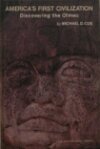Michael D. Coe (1929–2019)
Auteur de The Maya
A propos de l'auteur
Michael D. Coe is Professor Emeritus of Anthropology and Curator Emeritus in the Peabody Museum of Natural History at Yale University. His many other books include The Maya, Mexico, and The True History of Chocolate (with Sophie D. Coe), all published by Thames Hudson.
Crédit image: Michael D. Coe with Monument 34 of San Lorenzo
Œuvres de Michael D. Coe
Breaking the Maya Code 4 exemplaires
Three Maya relief panels at Dumbarton Oaks 3 exemplaires
Mayalar 1 exemplaire
A Triumph of Spirit: How Yuri Knorosov Cracked the Maya Hieroglyphic Code from Far-Off Leningrad 1 exemplaire
CD-ROM: Exploring the Lost Maya 1 exemplaire
A late preclassic village in Santa Rosa, Guatemala 1 exemplaire
The Shadow of the Olmecs 1 exemplaire
Oeuvres associées
Treatise on the Heathen Superstitions: That Today Live Among the Indians Native to This New Spain, 1629 (1982) — Directeur de publication, quelques éditions — 31 exemplaires
Handbook of the Robert Woods Bliss Collection of Pre-Columbian Art (1963) — Introduction — 22 exemplaires
The Face of Ancient America: The Wally and Brenda Zollman Collection of Precolumbia Art (1988) — Avant-propos — 8 exemplaires
Étiqueté
Partage des connaissances
- Nom légal
- Coe, Michael Douglas
- Date de naissance
- 1929-05-14
- Date de décès
- 2019-09-25
- Sexe
- male
- Nationalité
- USA (birth)
- Lieu de naissance
- New York, New York, USA
- Lieu du décès
- New Haven, Connecticut, USA
- Lieux de résidence
- Massachusetts, USA
- Études
- Fay School, Southborough, Massachusetts
St Paul's School, Concord, New Hampshire
Harvard University (English literature|1945|archaeology|PhD|1950|1959) - Professions
- anthropologist
archaeologist
epigrapher
university professor
museum curator - Relations
- Coe, Sophie D. (spouse)
Dobzhansky, Theodosius (father-in-law)
Tozzer, Alfred M. (mentor) - Organisations
- CIA (national service|Taiwan)
University of Tennessee, Knoxville (teacher)
Yale University (Department of Anthropology|lecturer|1960|professor|retirement|1994)
Yale University Peabody Museum
Dumbarton Oaks Research Library and Collection (advisor) - Prix et distinctions
- National Academy of Sciences
Orden del Quetzal, Republic of Guatemala, 2004
Orden del Pop, Museo Popol Vuh, Universidad Francisco Marroquín, Guatemala, 2006
The Royal Anthropological Institute
Tatiana Proskouriakoff Award, 1989
James D. Burke Prize in Fine Arts, Saint Louis Art Museum, 2001 (tout afficher 7)
Linda Schele Award, University of Texas, 2008
Membres
Critiques
Listes
Prix et récompenses
Vous aimerez peut-être aussi
Auteurs associés
Statistiques
- Œuvres
- 40
- Aussi par
- 6
- Membres
- 3,554
- Popularité
- #7,139
- Évaluation
- 3.9
- Critiques
- 42
- ISBN
- 110
- Langues
- 8
- Favoris
- 1




















The author is quite clear that all ancient writing systems rely on a complex combination of phonetic and semantic signs while there are three great classes of writing systems: logographic, syllabic, alphabetic. The pillars for decipherment are:
1. The database must be large enough, with many texts of adequate length.
2. The language must be known, or at least a reconstructed, ancestral version, in vocabulary, grammar, and syntax; at the very minimum, the linguistic family to which the language of the script belongs should be known.
3. There should be a bilingual inscription of some sort, one member of which is a known writing system.
4. The cultural context of the script should be known, above all traditions and histories giving place names, royal name and title, and so forth.
5. For logographic scripts, there should be pictorial reference, either pictures that accompany the text, or pictorially derived logographic signs.
Both Mayan and its grammar are unlike any other language Westerners learned for there was no Rosetta Stone, no point #3 to light the way to decipherment.
The author does not whitewash Mayan history; “Notwithstanding the pious claims of a past generation of archaeologists, blood and gore were the rule not the exception among the city states of the lowlands…. favourite themes of Classic Maya reliefs are the stripping, binding, trampling, torture, and decapitation of captives.”
I was hoping the book would be along the lines of The Writing of the Gods: The Race to Decode the Rosetta Stone by Edward Dolnick with more pictures of word and sentence composition but on the whole, the book was a fine read.… (plus d'informations)